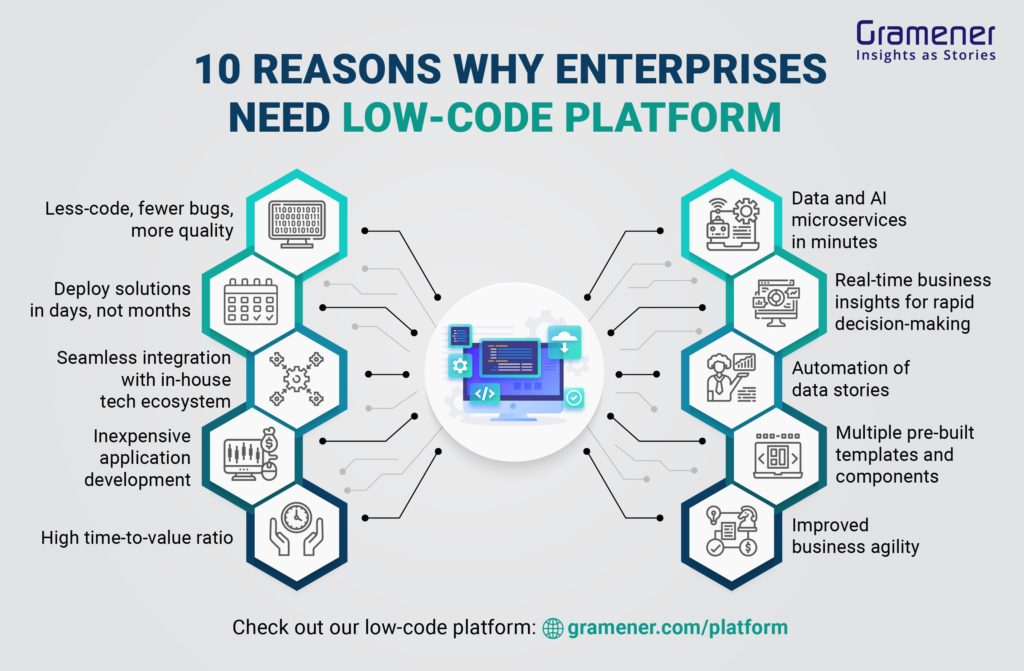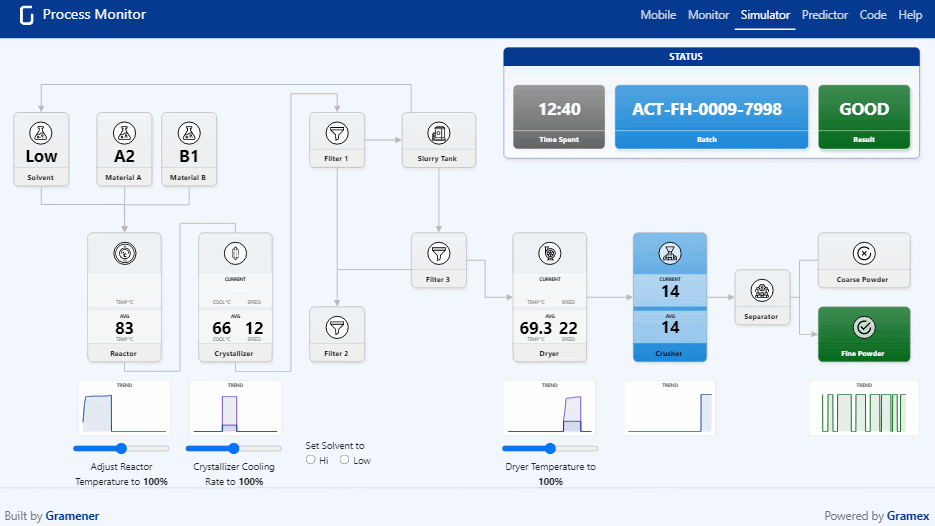In an analytics-driven enterprise world, the extraction of actionable insights should be faster to enable rapid decision-making. The CXO level business users rely on flawless dashboards and visual analytics platforms to convey insights. All that would depend upon how quick and efficient an application is. In this article, we’ll talk about why a low-code platform is the best solution for enterprises that are leveraging data and analytics to grow their business.
Table of Contents
What is Low-Code Platform?
“Low-code platforms employ visual, declarative techniques instead of traditional lines of programming. Both developers and non-developers can use these products, and they require less training to start. Common features include reusable components, drag-and-drop tools, and process modeling. Individuals or small teams can experiment, prototype, and deliver apps in days or weeks.”
– Forrester
The last line of the definition – Capability of low-code platforms to deliver applications in days or weeks – is the key reason why enterprises should go for it instead of the traditional code-heavy approach.
The Need for a Low-code Platform

Code is a liability. Applications are assets. Enterprises should focus on building applications with low code because more code means embedding repetitive code components, resulting in being more prone to bugs.
Gartner predicts that low-code platforms will drive 65% of all app development functions by 2024. Moreover, about 66% of big companies will use a minimum of four low-code platforms in their business environment.
A traditional development process of an analytics app is tedious and time-consuming. IT departments are always overwhelmed by the number of backlogs during application development.
Moreover, building data and analytics applications with traditional development approaches can severely inhibit developers’ bandwidth and go-to-market time of the application. If that happens, there are high chances of losing the chase to a competitor.
Analytics companies are using a low code approach to develop smarter Machine Learning solutions and services. The low code-enabled automated solutions allow citizen developers to add multiple components and features to the product.
For example, we developed a process monitoring application that monitors an organic synthesis process and uses Machine Learning to alert operators when quality drops.
Using real-time data of reactor temperature, crystallizer cooling rate, stirring speed, etc., we predict whether this batch will be good or bad.

This low-code Machine Learning application is built on Gramex and is production-ready for pharmaceutical manufacturing companies. Moreover, it was built with four views in 3 days using Gramex’s 8 components, replacing over 2,500 lines of code.
Benefits of Building Analytics Apps With Low-Code Platform
Forrester’s study expects the market for low-code development platforms to increase from $3.8 billion in 2017 to $21.2 billion by 2022.
Earlier this year, Google acquired Appsheet, an 8-year-old low-code mobile application building platform. Google says that this acquisition intends to empower millions of citizen developers to easily create and extend applications without the need for professional coding skills.
What benefits did Google see in it? Can you spot the benefits yourself?
Less Code, Less Bugs, More Quality
A low-code approach helps you cut down thousands of lines of code from your app structure. It is high time to cut down on repetitive code structures. Every solution has a set of repetitive codes.
A low-code development approach transforms those repetitive codes into components. Developers can place the components in their solution and cut down thousands of lines.
Not just that. A low-code approach also enables non-coders in the organization to use drag and drop builders and create data and AI products rapidly. A study from Mendix says that 24% of low-code users have 0% programming experience and 40% of users come from a mostly business background.
Deploy Data and AI Products in Days, Not Months
According to a Project Management Institute study, nearly half of all IT projects take more time than anticipated to get the solution production-ready. Rapidly building enterprise-grade analytics applications is the need of the hour.
A low-code platform can dramatically speed up the software development process and reduce the go-to-market time by 50%.
While early stages such as requirements gathering will take just as much time as before, low-code platforms use built-in apps, pre-built components, and templates, microservices, and open-source libraries to shorten the development process.
Seamless Integration with In-house Tech Ecosystem
While buying a low-code platform, an enterprise must think of building on top of the existing technology environment. Not every platform will offer seamless integration. Some teams use apps like SAP or SalesForce, while others use Tableau or Power BI. However, the end-goal is the same – generating insights as part of their toolset without disrupting their workflow.
Gramex is our open source low-code analytics platform that helps our enterprise clients integrate their Tableau, Power BI, Qlik, Microstrategy, and other dashboards.
The open-source version comes with a plethora of pre-built templates, microservices and components to build AI and ML Applications. However, the feature-rich enterprise version comes with full support and services from Gramener.
Inexpensive Low-Code Application Development
Beating the expensive cost structure is another aspect of why enterprises should prefer low-code platforms over traditional app development. Hiring experienced developers is one of the biggest challenges on the cost side. Low-code solutions require less engineering effort, so this automatically lowers the cost in the long run.
High Time-to-Value Ratio
A successful business decision trumps everything in the enterprise world. Adapting a low-code development strategy breaks down the silos and fosters a strong partnership between business and technology, leading to quick decisions.
Best Cross-Platform Mobility
A low-code platform can build various data and analytics applications, ranging from CXO-dashboards to visual analytics platforms. The pre-built templates ensure that the application offers an excellent experience to the business users over multiple platforms.
Low Code for Data Analytics
If you are an analytics customer, your service provider and data app builder should offer you an interface to explore insights. They should provide you with components that replace repetitive codes at the back end of the application.
Here’s how going low-code can help in your data science initiatives.
Build Data Visualizations with Low-Code Platform
Humans are not number crunchers but pattern recognition and storytelling animals. Our brains process pictures a thousand times faster than numbers or text. Building insightful data visualizations becomes super easy when you bring a low code approach into it.
Just explore this flow diagram for service requests or this exploration of the software ecosystem. We crafted these data visualizations on our low-code platform, Gramex.
Real-time Business Insights for Rapid Decision-Making
We believe insights are analyses that are big, useful, and surprising. By automating analysis patterns into libraries, a low-code platform makes it easy for developers to embed analytical components.
Our Clustering solution is a prime example of how the same pattern of insights can help analyze clusters of Telecom subscribers, Bank customers, and even flats in Singapore.
Going a step ahead, you can also build are AI-driven conversational applications that help business users by narrating insights. We built a conversational AI with our Low-code platform, Gramex that speaks business insights from media performance dashboards.
Automation of Data Stories
Building data stories is a non-conventional approach to convey insights. Insights are essential and actionable. Stories are memorable. Data storytelling is the amalgamation of the two philosophies and enables business users to memorize actionable insights.
With our low-code platform, Gramex, you can create any number of data stories and automate data narratives in simple English or any other language. If you are fond of telling data stories through comics, we have Comicgen, an open-source comic tool integration.
Data and AI Microservices in Minutes
Moving a prototype to production is a hassle. We like keeping our apps small but inter-operable. Gramex makes creating micro-services easier.
For example, exposing any database or an Excel file as a REST API requires zero code and just a few lines of configuration with the FormHandler micro-service.
Improved Business Agility
Low-code platforms will allow citizen developers to build applications in no time. On the other hand, it’ll free up the bandwidth of professional developers and enable them to focus on other code-intensive tasks. We offer components that you can assemble or dismantle on the go to mold the application according to your need.
Join the Low-Code Revolution
We started the low-code revolution to build analytics applications with fewer bugs. Offering easy maintenance, integration with any platform, and seamless deployment on any server to generate insightful data stories is our motive. To support the initiative, we educate our customers and other low-code enthusiasts about how we do what we do.
Watch our webinar on building data and AI products with a low-code development approach. The session was hosted by Anand S, Gramener’s CEO and Co-founder, who spearheads Gramex development.
Major areas this webinar focused on were:
- Making the Build vs. Buy Decision
- How a low-code approach will work for your specific data/digital needs
- Production-ready use cases to evoke your thought process

